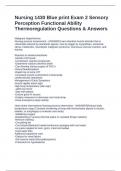Nursing 1430 Blue print Exam 2 Sensory
Perception Functional Ability
Thermoregulation Questions & Answers
Malignant Hyperthermia
Nursing process Assessment - ANSWERS-rare inherited muscle disorder that is
chemically induced by anesthetic agents. Can be trigger by myopathies, emotional
stress, heatstroke, neuroleptic malignant syndrome, strenuous exercise exertion, and
trauma.
Reaction to inhaled anesthetic
-Monitor C02 levels
-Unchecked, reaction progresses
-Dantrolene sodium prevents death
-Can develop during surgery of PACU
Clinical Manifestations
-Rapid rise in temp HTT
-Increased muscle contractions,Tachycardia
cardiovascular,respiratory
Management of Early Symptoms
muscle rigidity (early sign)
High body temperature (late sign)
-100% O2 STAT
-Stay with patient
-Ensure good IV access
-Employ measures to decrease core body temp
-Keep emergency equip nearby
Heat stroke interventions Nursing process intervention - ANSWERSReduce body
temperature asap (Constant monitoring of temp with thermometer placed in rectum,
bladder, or esophagus to evaluate core temp)
-Stabilizing oxygen
-Establishing IV access (Normal saline or Lactated Ringer solution)
-Remove clothing
-Circulating fan
-Cool sheets/blankets/ towels/continuous sponging with cool water
-Ice packs applied to neck, groin, chest and axillae
-Cold water bath
Additional supportive care:
-Dialysis for renal failure
-Anti seizure meds (Benzodiazepines)
-Potassium for hypokalemia
,-Sodium bicarbonate to correct metabolic acidosis
-measurement of urine output
-Throughout treatment, the patient's status is monitored carefully, including vital signs,
ECG findings (for possible myocardial ischemia, myocardial infarction, and
dysrhythmias), central venous pressure (CVP), and level of responsiveness, all of which
may change with rapid alterations in body temperature
Hyperthermia teaching and Learning - ANSWERS-High temp, pulse, metabolic
-In response to infection/tissue breakdown
-Flushing, warm ski, vomiting, diarrhea, body aches, fatigue, weakness, seizures (3 mo-
5yr)types of fever
febrile seizures- usually in infants and children between 3months and 5 years
intermittent- the body temperature returns to normal at least once every 24 hours
remittent- the body temperature does not return to normal and fluctuates a few degrees
up or down.
sustained- the body temperature remains above normal with minimal variations.
relapsing- The body temperature returns to normal for one or more days with one more
episode of fever , each as long as several days.
Causes of fever
-may occur response to infection
-may occur tissue breakdown
following myocardial infection , malignancy , surgery , and trauma
risk factors
-diminished immune response
-child in daycare
treatment
-tyneol and ibuprofen
-antibiotics
Frostbite( hypothermia) treatment select all that apply - ANSWERS-Remove jewelry or
clothing that could impair circulation in the body
- the patient should not be allowed to ambulate
-frozen extremities are placed in a circulating bath that is 37 C to 40c (98.6f to 104F)for
30 minutes
-give patient a pain medication for pain
-do not massage body to avoid mechanical injury
-Additional measures that may be carried out when appropriate after emergency
stabilization measures have been instituted include the following:
, • Whirlpool bath for the affected body parts to aid circulation and débridement of
necrotic tissue to help prevent infection
• Escharotomy (incision through the eschar) to prevent further tissue damage, to allow
for normal circulation, and to permit joint motion
• Fasciotomy to treat compartment
-After rewarming, hourly active motion of any affected digits is encouraged to promote
maximal restoration of function and to prevent contractures. Discharge instructions also
include encouraging the patient to avoid tobacco, alcohol, and caffeine because of their
vasoconstrictive effects, which further reduce the already deficient blood supply to
injured tissues.
because of their vasoconstrictive effects
Thermoregulation of the newborn nursing process - ANSWERSOn average, a
newborn's temperature ranges from 97.9° to 99.7°F (36.6° to 37.6°C). Since newborns
lose heat easily after birth, having skin-to-skin contact with their mothers is
recommended as the initial method for maintaining newborn body temperature. Skin-to-
skin contact should be the first line of treatment for hypothermia and as a measure to
reduce discomfort from painful procedures
Dry the newborn immediately after birth to prevent heat loss through evaporation.
•Wrap the baby in warmed blankets to reduce heat loss via convection.
•Skin-to-skin contact with mother as soon as stabilized
.•Use a warmed cover on the scale to weigh the unclothed newborn
.•Warm stethoscopes and hands before examining the baby or providing care
.•Avoid placing newborns in drafts or near air vents to prevent heat loss through
convection
.•Delay the initial bath until the baby's temperature has stabilized to prevent heat loss
through evaporation.
•Avoid placing cribs near cold outer walls to prevent heat loss through radiation.
•Put a cap on the newborn's head after it is thoroughly dried after birth.
•Place the newborn under a temperature-controlled radiant warmer
-Newborns have several characteristics that predispose them to heat loss:
•Thin skin with blood vessels close to the surface•Lack of shivering ability to produce
heat until 3 months old•Limited stores of metabolic substrates (glucose, glycogen,
fat)•Limited use of voluntary muscle activity or movement to produce heat•Large body
surface area relative to body weight•Lack of subcutaneous fat, which provides
insulation•Little ability to conserve heat by changing posture (fetal position)•No ability to
adjust their own clothing or blankets to achieve warmth•Inability to communicate that
they are too cold or too warm
thermoregulation of infant nursing process - ANSWERSThe differential diagnosis of
fever is broad and includes both infectious and noninfectious causes, with the majority
of febrile children having an underlying infection. The most common causes are minor
or more serious infections of the respiratory system, gastrointestinal tract, urinary tract,
or central nervous system. While most children have identifiable causes for their fevers,
many have fevers without localizing signs or symptoms. These fevers, which are usually




